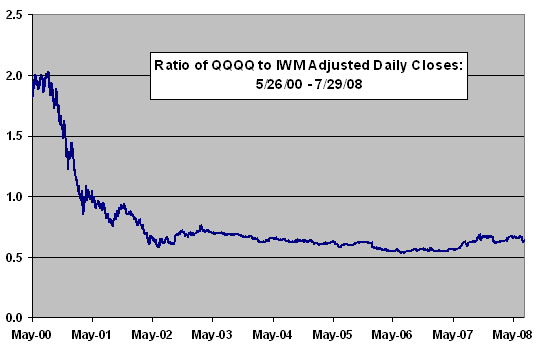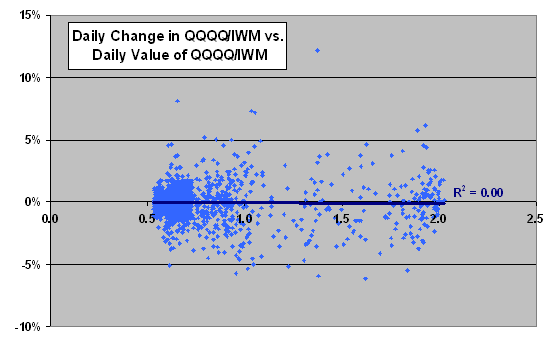A reader suggested that reversion in the relationship between PowerShares QQQ (QQQQ) and iShares Russell 2000 Index (IWM) may support short-term trading. To check, we consider: (1) the QQQQ-IWM ratio over the long term; (2) this ratio relative to its six-month moving average; and, (3) unusual daily divergences between these two exchange-traded funds. Using daily adjusted closing prices for QQQQ and IWM over the period 5/26/00 (the earliest available for IWM) through 7/29/08, we find that:
The following chart depicts the ratio of daily QQQQ price to daily IWM price over the entire sample period. Since May 2002 (post-Internet bubble), the ratio has stayed in the range 0.53 to 0.76.
Is there a relationship between the value of this ratio and the daily movement of the ratio?

The following scatter plot relates the daily change in the QQQQ-IWM ratio to the value of the ratio. The cluster of points at the far right is from the early part of the sample, while the one at the left is more recent. The Pearson correlation between the two series is -0.02, and the R-squared statistic is 0.00, indicating the level of the ratio explains none of its daily movement.
Is there inherent reversion or continuation in the daily changes of the QQQQ-IWM ratio?

The autocorrelation of daily changes in the QQQQ-IWM ratio with next-trading day changes in the ratio is 0.00, indicating no systematic reversion or continuation of changes by day.
Are extreme conditions for the value of the ratio and for daily changes in the ratio predictive? To check, we test the following joint conditions that might represent extreme overvaluation of QQQQ relative to IWM:
- The QQQQ-IWM ratio must be at least 5% above its six-month moving average, and
- The QQQQ-IWM ratio must have increased by at least 1% from the prior trading day.
These joint conditions apply to 43 trading days over the entire sample period. The average change in the QQQQ-IWM ratio the next trading day after these 43 instances is +0.09%, meaning that on average the ratio grows very slightly the next trading day. The ratio grows the next day 24 times and shrinks 19 times. These results do not support a view that QQQQ is tradably overvalued with respect to IWM.
However, there are nine pairs of consecutive trading days among these 43 days. Someone who has already committed funds the first day of each pair would not be able to trade the second day. Discarding these untradable signals leaves 34 instances. The average change in the QQQQ-IWM ratio the next trading day after these 34 instances is +0.29%, indicating some tendency for the ratio to grow the next trading day, but sample size is small. The ratio grows the next day 22 times and shrinks 12 times. Again, these results do not support a view that QQQQ is tradably overvalued with respect to IWM.
In summary, several simple tests refute a belief that the past relative behavior of QQQQ and IWM reliably predicts reversion in their near-term future relative behavior.